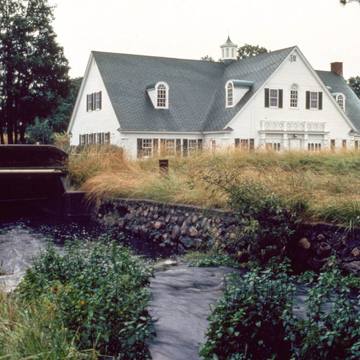You are here
Paris Park (Paris Fish Hatchery)
In 1881 the State Board of Fish Commissioners established the Paris Fish Hatchery at the site of Cheney Creek, a tributary to the Muskegon River, and alongside the Grand Rapids and Indiana Railroad tracks. This was Michigan's second fish hatchery, the first having been established in 1873 at Crystal Springs, near Pokagon, in Cass County, in which salmon and trout fingerlings were artificially propagated and reared for transportation in specially equipped railroad cars to other hatcheries for implantation in streams. A hatchery, ponds, and overseer's residence were constructed on the west side of the highway. In 1887 a second hatchery building, 40 × 80 feet in plan, was built on the east side of the highway. Cram of Detroit designed both hatcheries. The design of the steeply pitched gable-roofed, board-and-batten structures was duplicated later in the hatchery built at Sault Ste. Marie in 1894. In 1937, as the fish hatchery program reached its peak in Michigan, and under the auspices of the Works Progress Administration (WPA), the hatch house of 1887 was expanded, renovated, and given its present Colonial Revival appearance. The white-painted clapboarded building has arched dormers in its steeply pitched intersecting gable roof, a cupola, and green-painted shutters.
On Paris Creek at Paris (west side of Northland Drive, 0.1 miles north of Water Street) is a cobblestone hatch house, well house, and retaining wall erected in 1933 to the plans of Ernest Batterson of Kalamazoo, under the sponsorship of the federal government (WPA or the Civilian Conservation Corps [CCC]). Because the water supply was insufficient, it was closed shortly after opening.
The fish-rearing ponds have always been the pride of the local citizenry. Since 1976 the Mecosta County Park Commission has operated the hatchery as a county park.
Writing Credits
If SAH Archipedia has been useful to you, please consider supporting it.
SAH Archipedia tells the story of the United States through its buildings, landscapes, and cities. This freely available resource empowers the public with authoritative knowledge that deepens their understanding and appreciation of the built environment. But the Society of Architectural Historians, which created SAH Archipedia with University of Virginia Press, needs your support to maintain the high-caliber research, writing, photography, cartography, editing, design, and programming that make SAH Archipedia a trusted online resource available to all who value the history of place, heritage tourism, and learning.















